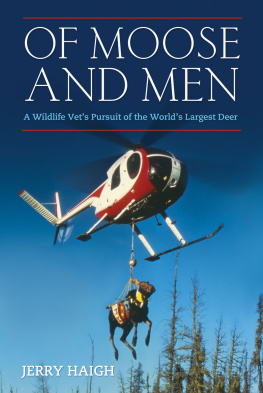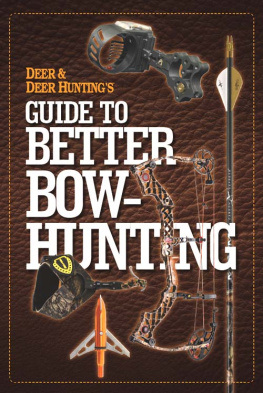Thank you for purchasing this Deer and Deer Hunting eBook.
Sign up for our newsletter and receive special offers, access to free content, and information on the latest new releases and must-have deer and deer hunting resources! Plus, receive a coupon code to use on your first purchase from ShopDeerHunting.com for signing up.
or visit us online to sign up at
http://deeranddeerhunting.com/ebook-promo
introduction
YOU CAN BECOME A BETTER BOWHUNTER
 BOWHUNTING FOR WHITE-TAILED DEER has witnessed an explosion of interest in the past 20 years. As whitetail populations have soared and bowhunting gear and tactics have gone mainstream, more and more deer hunters are picking up stick and string to chase their favorite quarry.
BOWHUNTING FOR WHITE-TAILED DEER has witnessed an explosion of interest in the past 20 years. As whitetail populations have soared and bowhunting gear and tactics have gone mainstream, more and more deer hunters are picking up stick and string to chase their favorite quarry.
Today, the sport ranks higher in participation than almost any other form of hunting after whitetail gun hunting. In fact, archery has become so popular the National Archery in the Schools Program is set to surpass Little League Baseball in participation. This surge in interest means bowhunting is still relatively new for many folks. In fact, beginners and intermediate archers make up a large portion of Americas 3.2 million bowhunters and these folks are hungry for expert information. Even seasoned archery veterans find the sport is continually evolving with new, cutting-edge products entering the market every year. Add it all up and the hunting world is hungry for practical and comprehensive archery insights.
Along the way Deer & Deer Hunting magazine has been recognized as a leader in sharing the techniques and gear that make us better archers and hunters. This book is a compilation of the very best tips and strategies from our No. 1 archery expert, Bob Robb. Inside these pages, Robb shares shooting advice, insights on critical gear, bowhunting techniques and tons of helpful hints for in-the-field archery success.
Presented in a straightforward, no-nonsense approach, Deer & Deer Huntings Guide to Better Bowhunting highlights all the little things archers can do to get more out of their archery gear. It offers real-world examples and examines the latest products that can help you in the woods. In fact, the detailed advice will help any archer from the Rocky Mountains to the target range. If youve ever wondered about which broadheads to use, why we miss angled shots or what type of bow is best for your shooting style, this book will answer those questions and more!
This cutting-edge information is sure to make you a better bowhunter and shooter, whether you are a beginner or seasoned expert.
Welcome to the world better bowhunting. You can become a better bowhunter. 
chapter 1
12 STEPS TO BETTER BOWHUNTING
 WITH SERIOUS WHITETAIL SEASON UPON US, the last thing you want to do is rush off to your favorite stand and find out that some little thing you never anticipated turns that gimme shot into a goner.
WITH SERIOUS WHITETAIL SEASON UPON US, the last thing you want to do is rush off to your favorite stand and find out that some little thing you never anticipated turns that gimme shot into a goner.
Thats why final preparations are so important.
The key is to anticipate problems before they happen and solve them at home. To that end, here are some things you may not think about much until it is too late.
1. FINE-TUNE YOUR ARROWS. Before hunting season, make sure you have a dozen broadhead-arrow shaft combinations that fly like laser beams. Shoot every one of them at least a couple of times to ensure they are flying right and also impact where the sight pins say they should. Weigh the fletched shaft and broadhead, both separately and together, the goal being to have a quiver full of finished shafts that weigh within 3 to 5 grains of each other. When its time to hunt, either re-sharpen your blades or replace them with scalpel-sharp blades from a new pack.
2. SIGHT IN WITH BROADHEADS. Beginning in late summer, I quit shooting field tips altogether. If you have been using field tips and are just now switching to broadheads, make sure you practice with exactly the same arrow/broadhead combination you will hunt with. This means first shooting them through paper to make sure the bow is precisely tuned with this combination. Youll probably have to make some arrow-rest adjustments to achieve this. Then re-sight the bow using the broadheads. Do not be satisfied with a bow that is only sort of tuned!
Even new bows with no-stretch bowstrings will have the strings stretch at first, which can rotate the peep into a different position after a while.
3. CHECK YOUR BOWSTRING. Check the string and cable system for wear, paying attention to those areas where it rolls through the wheels and, if you do not use a string loop, where your release attaches directly to the string. Then lightly wax it.
4. PEEP CLOSELY. Do you use a peep sight without a rubber tube that forces it back into the proper position every time? Then make sure yours does turn back the right way. Even new bows with those supposed no-stretch bowstrings will have the strings minutely stretch at first, which, of course, rotates the peep into a different position after a while, so check it, fix it and then use an indelible marker above and below the peep to mark its exact position.
5. LOCK IT DOWN. Check all the screws that secure accessories to the bow, including your quiver and sight, and make sure they are locked down.
6. LUBRICATE IT. Its time to lubricate the bows axles and also the moving parts of your release aid. I do so with a graphite product that will not freeze when the weather turns bitter.
THE LAST THING YOU WANT TO DO IS RUSH OFF TO YOUR FAVORITE STAND AND FIND OUT THAT SOME LITTLE THING YOU NEVER ANTICIPATED TURNS THAT GIMME SHOT INTO A GONER.
7. PAD IT. I pad the heck out of everything that has even the smallest chance of making noise on stand with stick-on moleskin or fleece. The bottom of my bow sight, the arrow shelf, arrow rest prongs they all get covered up. I also have covered my entire laser rangefinder in moleskin, then covered that with a layer of the same tape hockey players wrap their sticks with. Hockey tape is an awesome product for bowhunters because it is tough, quiet and, best of all, does not get stiff when temperatures drop below freezing.
8. TRY SPECIFICITY TRAINING. This is a term coined by exercise physiologists when training athletes to perform to their maximum potential at specific tasks. For example, a sprinter trains his legs and cardiovascular system so he can run his fastest, and doesnt spend a lot of time lifting heavy weights with his upper body. For bowhunters, that means replicating in practice as closely as possible those shots you will most likely get at deer. That means that, while standing at a target line on the range is great practice, shooting from an elevated platform is much better as a final tune-up for tree-stand hunting. If you hunt from a ground blind, practice shooting from the sitting position. As it gets closer to hunting, I like to wear my hunting clothes, put my binoculars and laser rangefinder around my neck just as I would when hunting, then play games with myself as I go through my mental shot checklist.














 BOWHUNTING FOR WHITE-TAILED DEER has witnessed an explosion of interest in the past 20 years. As whitetail populations have soared and bowhunting gear and tactics have gone mainstream, more and more deer hunters are picking up stick and string to chase their favorite quarry.
BOWHUNTING FOR WHITE-TAILED DEER has witnessed an explosion of interest in the past 20 years. As whitetail populations have soared and bowhunting gear and tactics have gone mainstream, more and more deer hunters are picking up stick and string to chase their favorite quarry.
